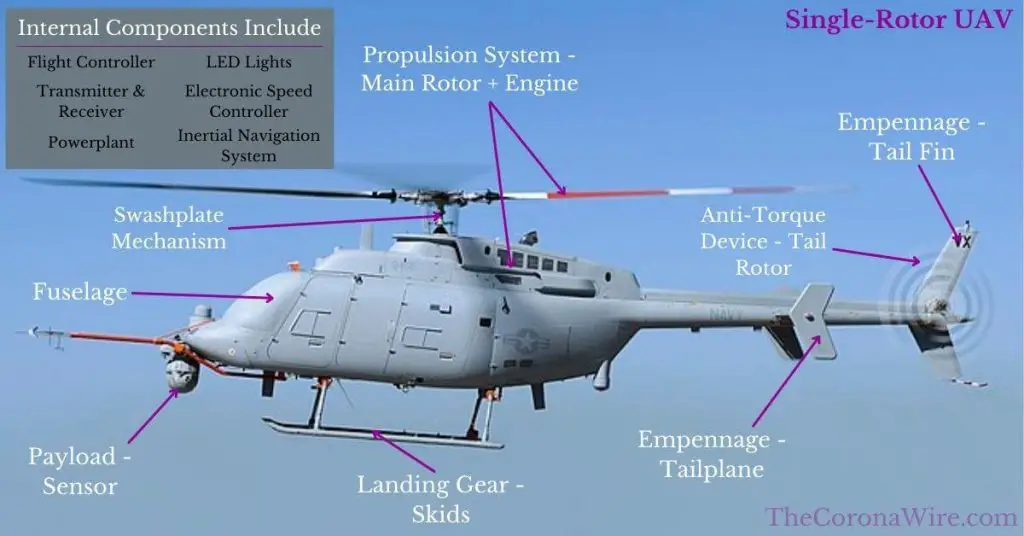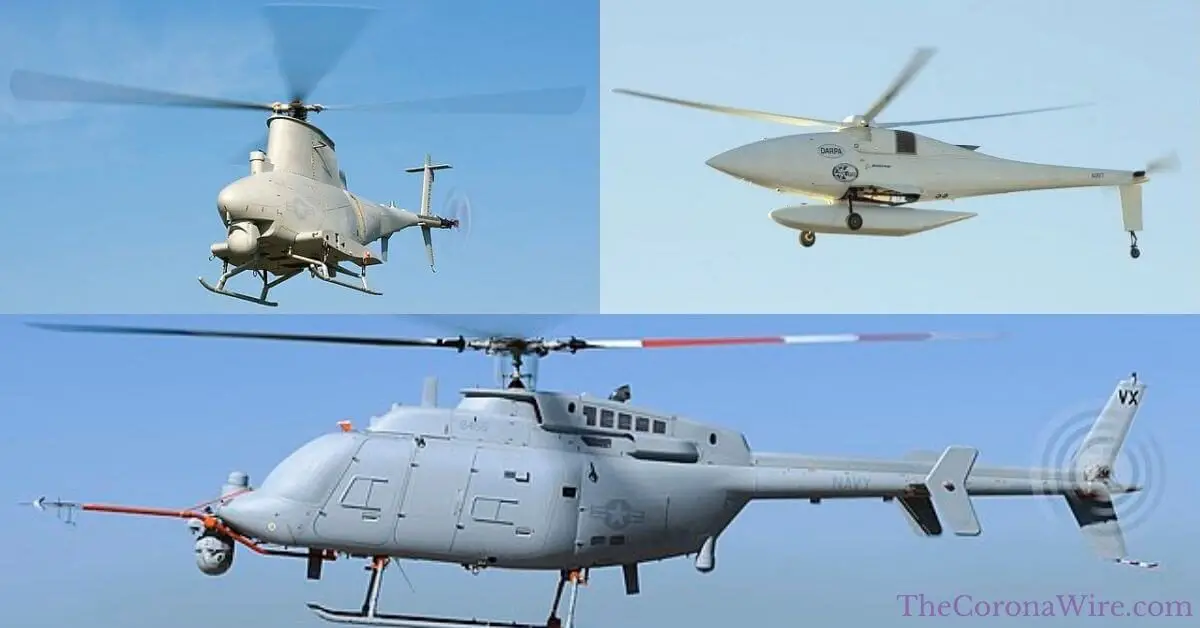Single-rotor drones are unmanned helicopters that have been around for a very long time. These types of unmanned aerial vehicles (UAVs) rival the fixed-wing UAV configuration.
What are single-rotor drones/UAVs?
Single-rotor drones/unmanned aerial vehicles (UAVs) are types of rotary-wing UAVs that have a single main rotor and an anti-torque device.
- How Do Single-Rotor UAVs Work?
- What Are The Types Of Single-Rotor UAVs?
- Differences Between Single-Rotor, Twin-Rotor & Multi-Rotor Helicopters?
- What Are Single-Rotor UAVs Used For?
- What Parts/Components Make Up Single-Rotor UAVs?
- What Are The Advantages & Disadvantages Of Single-Rotor UAVs?
- What Are Some Examples Of Single-Rotor UAVs?
- Conclusion
How Do Single-Rotor UAVs Work?
Single-rotor UAVs use a single rotor that acts as a small airfoil spinning at rapid speeds to capture airflow as that air is forced downwards causing a pressure difference that creates a suction effect thus generating lift. The direction they travel is changed by altering the angle of the propeller.
Check out our full post on what rotary-wing drones/UAVs are where we dive into how they work, applications, parts/components, advantages/disadvantages, common powerplants and examples:
Related Post: What Are Rotary-Wing UAVs? Unmanned Rotorcraft Explained
These types of drones actually use the same principle as fixed-wing UAVs in the way they generate lift. These rotors are used as airfoils just like the wings of a fixed-wing aircraft.
The main rotor provides lift while an anti-torque device controls the UAV on its yaw axis.
Anti-torque devices include multi-bladed tail rotors and ducted fans/fenestron.
Some single-rotor UAVs do not use a conventional anti-torque device. These types are called no tail rotor (NOTAR) single-rotor UAVs (more on how they function below).
The rotor/airfoil is sized and shaped in a way that captures the flow of air as the speed the prop rotates increases thus producing lift.
Air flows faster on the curved top side of the blade than on the flatter underside due to its shape. This causes less air pressure to accumulate on the top of the prop creating a suction that lifts the prop up enabling both unmanned fixed-wing and rotary-wing drones to fly.
These drones obtain energy to produce thrust from powerplants such as engines, batteries, fuel cells, powered drone tethers among others.
They also incorporate other devices such as propellers that are powered by electric motors.
Check out our full post where we dive into several powerplants + propulsion devices used in drones. We expand on how they work, the types, advantages/disadvantages, and real examples of drones that use it.
Related Post: How Are Drones Powered? 6 Drone Energy Sources Explained
What Are The Types Of Single-Rotor UAVs?
Single-rotor drones can also be separated into different types based on the tail control systems they use.
Here are the types of single-rotor drones/UAVs:
- Single-rotor drone with multi-bladed tail rotor
- Single-rotor drone with ducted fan/fenestron
- Single-rotor drone with no tail rotor (NOTAR)
Single-rotor drones/UAVs with multi-bladed tail rotors
Single-rotor drones/UAVs with multi-bladed tail rotors are the most common type of rotary-wing UAV. These types of drones use a small tail rotor located at the empennage to control the UAV’s yaw.
Many single-rotor helicopters can change the pitch of each individual blade on the tail rotor system in order to change the thrust they generate.
The drawback to these types of drones is that the main rotors can sometimes negatively affect the efficiency of the tail rotor.
Single-rotor drones/UAVs with ducted fans/fenestron
Single-rotor drones/UAVs with ducted fans/fenestron are rotary-wing UAVs that use a small tail rotor encased in a shell/duct located at the empennage to control the UAV’s yaw.
The drawback to these types of drones is that the ducted fan system weighs a lot more reducing the overall efficiency of the unmanned helicopter.
Single-rotor drones/UAVs with no tail rotor (NOTAR)
These types of single-rotor drones are very rare in the unmanned systems industry.
Single-rotor drones/UAVs with no tail rotor (NOTAR) are rotary-wing UAVs that do not have an anti-torque device located at the tail of the aircraft.
Some NOTAR unmanned helicopters use a fan within the tail to build up low-pressure air which creates a boundary layer that changes the direction the air flows at the tail.
Another type of NOTAR helicopter is the tip jet-powered helicopter which uses small jets at the tips of each main rotor blade to spin the rotor thus eliminating all torque placed on the fuselage.
Check out our full post on the types of rotary-wing UAVs where we dive into what each type is and how they work along with some examples of each:
Related Post: What Are The Types Of Rotary-Wing Drones/UAVs? (+Pictures)
Differences Between Single-Rotor, Twin-Rotor & Multi-Rotor Helicopters?
We will be including every difference except for the obvious fact that they have different numbers of rotors (Single with one plus anti-torque device, twin with two, and multi with three or more propellers).
Here are the differences between single, twin & multi-rotor UAVs?
| Single-Rotor UAVs | Twin-Rotor UAVs | Multi-Rotor UAVs | |
| Payload capacity | Typically higher payload capacity than twin+multi-rotor UAVs | Typically moderate payload capacity | Typically low payload capacity |
| Speed | Moderate speed | Moderate speed | Generally very high speeds |
| Weight | Average weight | Much heavier in general | Can be made very light |
| Operation Difficulty | Moderate operation difficulty | Very challenging operation difficulty | Generally very easy to operate |
| Stability | Moderate stability | Moderate stability | Very stable |
| Flight Time | Very high flight time | Moderate flight time | Typically very low flight times |
What Are Single-Rotor UAVs Used For?
Here are 5 applications for rotary-wing UAVs:
- Ski patrol operations
- ISTAR (Intelligence, Survelliance, Target Acquisition, and Reconnaissance)
- Photography/videography
- Crop monitoring
- Maritime search and rescue
Check out our full post on rotary-wing UAV applications where we explain what each application entails and how drones are used in them:
Related Post: 9 Awesome Rotary-Wing Drone/UAV Applications Explained
What Parts/Components Make Up Single-Rotor UAVs?
Single-rotor UAVs are made up of a fuselage, tailboom, tail assembly/empennage, anti-torque device, swashplate mechanism, powerplant, propulsion devices and often a small tailplane.

The fuselage is the primary body section of the UAV. It usually contains cargo such as passengers and some important internal components.
The tail boom is the structure connected to the back of the fuselage that supports a single-rotor UAVs tail assembly.
The tail assembly/empennage is the entire tail configuration which includes a fin (vertical stabiliser) that acts vertically and often a horizontal tailplane/stabiliser that acts horizontally.
A tailplane is a small wing typically placed on the tail of both fixed-wing and rotary-wing UAVs that acts as a horizontal stabiliser aiding in controlling the helicopter’s pitch and therefore stability.
The anti-torque device is a small control system (often a small rotor) located at the tail of an unmanned rotorcraft that eliminates the torque generated by the main rotor thus controlling the aircraft’s yaw.
Anti-torque devices can be small multi-bladed tail rotors, ducted fans/fenestron, and some helicopters don’t use one at all (NOTAR/no tail rotor).
Single and twin-rotor UAVs typically require a swashplate mechanism located at the rotor shaft consisting of a bottom and top independent swashplate (bottom is stationary and top moves with rotor) while being attached together via a bearing.
The top swashplate is attached to the rotor shaft via a driver and is also attached to the blades using control rods.
Swashplate mechanisms are required for the main rotor as they enable the operator to pivot the main rotor in the direction the operates wants to travel.
Common powerplants include engines, batteries, drone tethers, fuel cells (FCs) among others (more on this below).
Propulsion devices include propellers that in this case act as airfoils which are types of fins.
Check out our full article on rotary-wing parts/components where we dive into what each is, how they work and the different sub-types of each component (if any):
Related Post: Main Rotary-Wing Drone/UAV Parts & Components Explained
What Are The Advantages & Disadvantages Of Single-Rotor UAVs?
Single-rotor drones/UAVs are probably the second most popular rotary-wing configuration used in drones alongside multi-rotor UAVs which take first place.
We’ve split up the advantages and disadvantages into their own separate sections.
Single-rotor drone/UAV advantages
Here are 4 advantages of single-rotor unmanned aerial vehicles (UAVs):
- Their large main rotor can spin slower saving energy while generating the same amount of lift as multiple smaller rotors
- They can hover in place for extended periods of time
- They can operate for a longer periods of time than other types of rotary-wing UAVs
- They can takeoff and land in small spaces as they don’t require a runway
Single-rotor drone/UAV disadvantages
Here are 5 disadvantages of single-rotor unmanned aerial vehicles (UAVs):
- There are many moving parts creating vibrations that can make them less stable
- They are slower than multi-rotor UAVs specifically
- They typically have small payload capacities compared to other types of drones
- They are typically much louder than other types of UAVs
- They are often more prone to being negatively affected by crosswinds which can reduce the effectiveness of their rotor/s
Check out our full post on rotary-wing advantages and disadvantages where we explain several benefits and drawbacks to these UAVs:
Related Post: 11 Rotary-Wing Drone/UAV Advantages+Disadvantages Explained
What Are Some Examples Of Single-Rotor UAVs?
Here are 11 examples of single-rotor UAVs:
| Name | Manufacturer | Powerplant |
| MQ-8B Fire Scout | Northrop Grumman | Rolls-Royce Model 250 Engine |
| Camcopter S-100 | Schiebel | Austro Engine AE50R Wankel Engine |
| Alpha 800 | Alpha Security and Defense | Gasoline Engine+Backup Battery |
| VSR700 | Airbus | Thielert Centurion 2.0 Diesel & Jet Fuel Engine |
| Tanan 300 | Airbus Defense & Space+Cassidian | Diesel Engine |
| Vapor 55 | AeroVironment (Pulse Aerospace) | LiHv Battery |
| DZ15 | Doosan Mobility Innovation | Hydrogen Fuel Cell Powerpack |
| A160 Hummingbird (YMQ-18A) | Boeing | Pratt & Whitney Canada PW207D Engine |
| Vigilant | Techno-sud | 2-Stroke Piston Engine |
| NEO S-300 | Swiss UAV | JetA1 Single Turbine Engine |
| Unmanned Little Bird (ULB) | Boeing | Allison 250-C30 Turboshaft Engine |
If you’d like to discover who the best drone companies are in the world for the consumer, commercial and military drone markets and some fun facts about them, we have a full post on this topic below:
Related Post: Top Drone Companies/Manufacturers In The World [History, What They Offer, Popular Drones And More]
Conclusion
Thank you for reading! We hope you learned something new.
We highly recommend you check out our main article on what rotary-wing UAVs are to learn more about these incredible types of drones.
